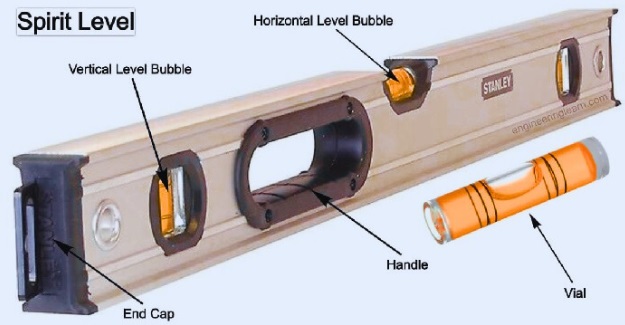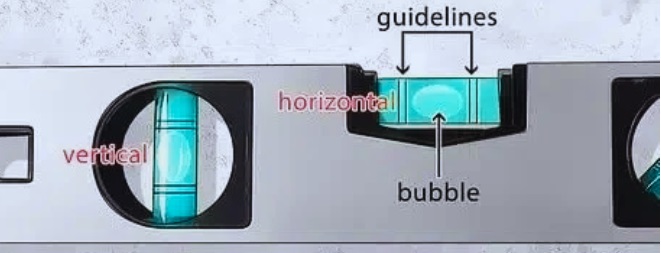The spirit level, also called a bubble level or just a level, is a tool used for defining the surface level in the form of horizontal or vertical. Different types of levels are used by stonemasons, carpenters, and other workers. Here we will cover details for the spring level and learn how to measure the bubble level. Let’s get started.
What is a spirit level?
- A spirit level is a device that is used for measuring the surface level, especially tabletops. The bubble tools are also called a spirit level.
- That is an angle-measuring tool that comes with a bubble that rises to the high point of the glass by fixing on the spring level of the upper surface.
- For working with a spirit level, just follow the bubble’s motion. Use two digits of scale on one side that define inclination 0.02 per unit.
- The reference plane configures the machine component where straightness is measured on a spring-level base.
- The bubble exists in the middle of the graded scale that is made on glass for a horizontal base.
Structure of Spirit Level
- The spirit level base ruler comes with a hollow chamber and bubble level unit. The leveling bubble unit comes with some other components like the bubble tube, bubble tube base, and fixing base.
- The bubble tube base comes with a limited slot for fixing the base. leveling bubble unit configured like in laying opening on the base ruler.
- The leveling bubble unit fixing base is set in the hollow chamber so the tip end of the fixing base is at the inner side of the inlaying opening for fixing the base in the hollow chamber.
- Variable clasps are configured on both sides of the fixing base top part, and the tip end of the elastic clasp comes with a slant resistance surface that provides resistance for the corners of the internal wall of the inlaying opening.
Parts of a Spirit Level
- Main parts of spirit levels are explained here.
Handles
- The screening level is easy to use with handles. It is the shape of slots in spirit levels. It helps to work longer, and some screening levels come with a handle that helps to use them in industries.
End Caps
- • The spirit level is hollow and lightweight, and the ends are open until we use plastic end caps. That helps dust particles stay away.
Vials
- Some levels have containers that are like spirit levels. That is a spirit-filled tube that is empty for making bubbles, which is used for checking the surface level.
- It is good for screening tools since it helps tools to be used for laying flat flooring. Some screening levels have 3 vials at different angles: horizontal, vertical, and 45 degrees.
Spirit Level Calibration
- For measuring the accuracy of the level used by the carpenter, the accurate definition of the horizontal surface is used. The level is put on flat and rough level surfaces, and bubble tube readings are checked.
- That value shows for which level surface is parallel with the horizontal plane; based on the level, what part is accurate is not known.
- The spirit level rotated through 180 degrees in the horizontal plane and then measured another value.
- If the level is error-free, it shows the same direction according to the horizontal plane. The difference shows an error in level values.
- Rotate the level and move the bubble tube to set the spiriting level, which gets half of the error, until readings are constant for the flipped level.
- This process is also used for different tools like surveyor optical levels and theodolites.
Sensitivity of spirit level
- Sensitivity is the main factor of a spirit level since device accuracy is based on sensitivity. The sensitivity level is the change in angle for a moving bubble at a unit distance.
- If the bubble comes with graduated divisions, sensitive is the angle that moves the bubble at these divisions.
- 2mm is the spacing used for graduation; on a surveyor level, the bubble moves 2 mm if the vial is moved at 0.005 degrees.
- For an accurate machine level of 2 mm, if the vial is tilted on division, the level varies 0.04mm one meter from the pivot point, which is defined as 5 tenths per foot.
- That shows a length of 5 tenths of 1 thousandth of an inch.
How to Read a Spirit Level
- First of all, find the bottom edge level; that is, on top of the surface where we are measuring level.
- Some types of scoring levels come with magnetic edges that stick to metallic surfaces for easy use.
- Check body level for grasping part where you do not block vials in hand.
- One end of some levels comes with punched holes for hanging over a workbench.
- • A tube vial in the central level helps to define accurate horizontal.
- The tube vials are found vertical on the ends.
- There is an angle tube vial on different levels, and some levels have a level angle of 45 degrees.
Working of Spirit Level
- First of all, clean the level, remove dust particles on the edges, and mark a line over the lower part of the wall.
- Flip the level so as to change the upper part to the lower. Not out new top edge over marked line. If the bubble is in the center point, it means the level is correct; if not, it is an error.
- Put the level on the surface of the body where there is a need to check accurate horizontal.
- Ensure the spirit tube is parallel with the object. Give some time to the bubble to float on top of the spirit tube.
- Set eye with level on spirit tube. For getting an accurate reading, close one eye and see.
- Check bubble location in spirit tube; if it is between lines on tube, it means object is at level point. If the bubble is at the right side of the line object, the slope is from right to left, and if the bubble is on the left side now, the slope is downward from left to right.
- For getting the right bubble, repeat this process again.
How to Level a Scope with a Bubble Level
- First of all, check that the rifle is without load. Put the rifle in a vise or gun cradle to keep the rifle at a strong point.
- Set bubble level on flat component of gun. If there is a 2nd spirit level, use it on another flat part, like over the chamber or on the rib.
- Tightly set the rifle in position after getting level, and put the scope in the ring.
- Scop snug tighten, and loose to shift.
- Now set bubble level on scop and make horizontally scope level.
- Move the level parallel with the scope and make it level in a vertical way.
- Now scope at the proper level.
Types of Spirit Levels
There are many types of spirit levels used for different applications.
- Carpenter’s level
- Engineer’s precision level
- Electronic level
- Mason’s level
- Torpedo level
- Post level
- Line level
- Inclinometer
- Slip or Skid Indicator
- Bull’s-eye level
Surveyor’s Leveling Tool
- The leveling tools are also called tilting levels, which are used for measuring height variations in larger roads and distances for surveys.
- The surveyors’ leveling tools come with a spirit level configured on the telescope and have cross-sectional hairs configured on the tripod.
- The users read height parameters of two vertical rods that have grading; the first one is behind and the other is in front for getting the height difference between ground points where the rods are resting.
- Start from a point where the elevation is not known, and measure the height difference while moving cross-country over long distances, and elevations are measured.
- Accurate leveling is used for providing the difference in elevation between two points one kilometer apart in some mm.
Carpenter’s level
- The normal carpenter level is like a short plank of wood and comes with a larger body for providing stability, and the surface is measured in a proper way. In the center of the spirit level is a small window for bubble and tube configuration.
- Two rings show a bubble if the surface is level. That shows a 45-degree inclination addition.
Line level
- The line level is a level made for handling builder string lines. The body of the level is configured with small hooks for helping to make a connection and hang from a string line extended to the plane level.
Read also What is Porosity in Welding? Causes, Types, Effects and Solutions
Magnetic Box Spirit Level
- It is like a box beam level with a magnet for providing connection with metallic bodies. The magnetic box level is used for making connections with metallic surfaces and making them level.
Screed Spirit Level
- This type of bubble level is used for laying flooring, especially for concrete and cement bases. They are also used for landscaping ground level. Metals are used for making these bubble levels.
FAQs
What are the uses of a spirit level?
- The spirit level is a tool that is used for showing parallel or vertical alignment of surfaces based on the earth. The sprint level name was given due to mineral sprinting in the level.
Why do we use a level tool?
- The level is a tool that is used for making horizontal plane alignment of objects, which is called leveling. It is used in conjunction with a leveling staff for making relative heights or levels of marks.
Where to use a spirit level ?
- • A spirit level is a tool used for checking surface alignment to ensure that they are vertically or horizontally aligned.
What are the rules for the spirit level?
- Check the location of the bubble in the spirit tube; if it is in the middle of the lines on the tube, it means the object is level. If the bubble is at the right side of the line object, the blob is right to left downward. If the bubble is left to line, the body is downward left-to-right.
What’s the difference between a spirit level and a level?
- The spirit level, bubble level, or level is a tool that is used for showing surface-level alignment in a vertical or horizontal direction.
What is the difference between a bubble level and a spirit level?
- The spirit level, also called a bubble level or water level, is used for checking that a surface is parallel or vertical. It comes with a rectangular body having one or more bubble vials.
What can I use instead of a spirit level?
- Hange shelf, connects tiles; the use of accurate leveling tools is important. Spirit and laser levels are commonly used tools for this purpose.

